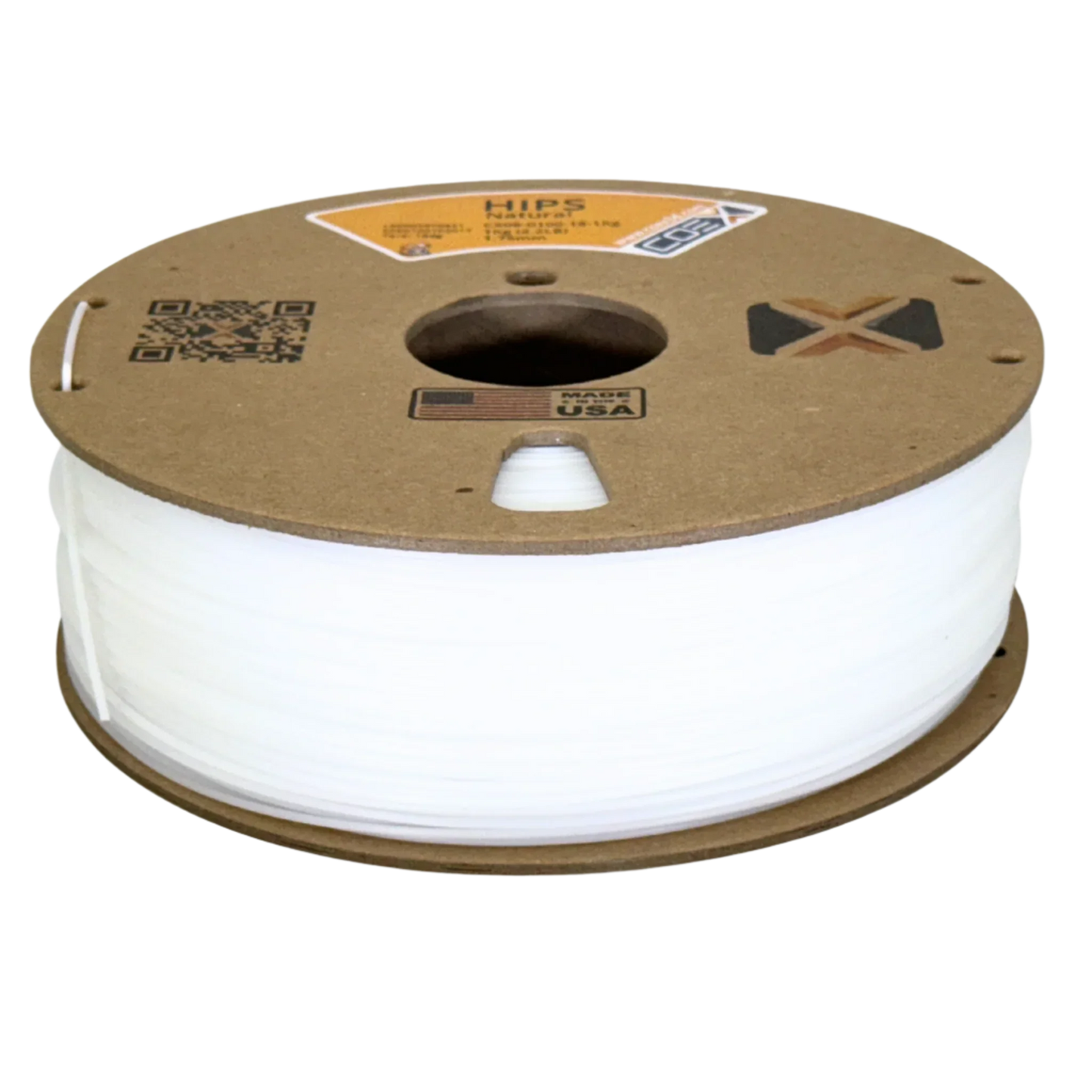
Coex Natural HIPS
HIPS (High Impact Polystyrene) is a dissolvable filament that is frequently used as support material. It acts as a great support material because it is easily removed with Limonene solution, leaving the clean high-quality print that you want behind. HIPS requires no scraping, cutting, or any other method of removal that may cause damage to your prints.
Technical Printing Guide - COEX HIPS
1. Material Notes
- HIPS can be dissolved with D-Limonene
- Keep filament dry - store properly and dry before use
- If needed, dry at 75°C for 3 hours or more
- Enclosure is necessary
- Use Z-offset slightly higher than PLA (+0.05mm)
- Enable "Avoid crossing perimeters" to reduce stringing
- Consider using the "Wipe while retract" option
- Enable "Slow down for small perimeters."
- Print outer walls slower for better quality
- Use a minimum layer time of 30 seconds for small parts
- Consider using "Extra Prime Amount" after retraction
2. Temperature Settings
Bed Temperature: 80-100°C
- Wash the bed often for good adhesion - Use dish soap and rinse thoroughly to remove oils
- Use bed adhesion products if necessary (gluestick, WELD3D)
- Use brim for tall or large prints
- Keep the ambient temperature stable
Extruder Temperature: 245-265°C
3. Basic Parameters
| Nozzle | Layer Height | Line Width | Volumetric Speed | Temperature |
| 0.4mm | 0.2mm | 0.42mm | 14.0 mm³/s | 250°C |
| 0.6mm | 0.3mm | 0.62mm | 31.5 mm³/s | 255°C |
| 0.8mm | 0.4mm | 0.82mm | 56.0 mm³/s | 260°C |
| 1.0mm | 0.5mm | 1.02mm | 87.5 mm³/s | 265°C |
4. Speed Settings
0.4mm Nozzle (Volumetric Speed: 14.0 mm³/s)
| Line Type | Percentage | Speed |
| External Perimeter | 50% | 83.33 mm/s |
| Internal Perimeters | 75% | 125.00 mm/s |
| Infill | 100% | 166.67 mm/s |
| Top/Bottom | 60% | 100.00 mm/s |
| First Layer | 30% | 50.00 mm/s |
0.6mm Nozzle (Volumetric Speed: 31.5 mm³/s)
| Line Type | Percentage | Speed |
| External Perimeter | 50% | 84.68 mm/s |
| Internal Perimeters | 75% | 127.02 mm/s |
| Infill | 100% | 169.35 mm/s |
| Top/Bottom | 60% | 101.61 mm/s |
| First Layer | 30% | 50.81 mm/s |
0.8mm Nozzle (Volumetric Speed: 56.0 mm³/s)
| Line Type | Percentage | Speed |
| External Perimeter | 50% | 85.37 mm/s |
| Internal Perimeters | 75% | 128.05 mm/s |
| Infill | 100% | 170.73 mm/s |
| Top/Bottom | 60% | 102.44 mm/s |
| First Layer | 30% | 51.22 mm/s |
1.0mm Nozzle (Volumetric Speed: 87.5 mm³/s)
| Line Type | Percentage | Speed |
| External Perimeter | 50% | 85.78 mm/s |
| Internal Perimeters | 75% | 128.68 mm/s |
| Infill | 100% | 171.57 mm/s |
| Top/Bottom | 60% | 102.94 mm/s |
| First Layer | 30% | 51.47 mm/s |
5. Retraction Settings
IMPORTANT: Set travel speed to the maximum your machine allows (200-500mm/s). Faster movements reduce filament oozing time, minimizing stringing.
| Nozzle | Distance | Speed | Z-Hop |
| 0.4mm | 1.0-1.5mm | 40mm/s | 0.2mm |
| 0.6mm | 1.0-1.5mm | 40mm/s | 0.2mm |
| 0.8mm | 1.0-1.5mm | 40mm/s | 0.2mm |
| 1.0mm | 1.0-1.5mm | 40mm/s | 0.2mm |
6. Cooling Settings
Cooling Configuration:
-
- First Layer: 0% (fan off)
- General Printing: 100% base fan speed
- Bridges and Overhangs: 100% fan speed
- Layers < 15 seconds: 100% fan speed
7. Troubleshooting Guide
| Problem | Solution |
| Irregular extrusion |
1. Dry the filament 2. Check the extruder 3. Reduce speed |
| Poor adhesion |
1. Dry the filament 2. Use adhesive 3. Adjust the first layer |
| Stringing |
1. Dry the filament 2. Adjust retraction 3. Increase travel speed 4. Check temperature |
PLEASE NOTE: These printing parameters are initial recommendations based on our experience. They may need adjustment depending on your specific 3D printer, environmental conditions, and the geometry of the part you are printing. Use these settings as a starting point and fine-tune them according to your specific needs.
CX06 HIPs Technical Data Sheet
Technical Data Sheet: CX06 HIPS 3D PRINTING FILAMENT
TDS Rev 2.0
BASE RESIN: AmSty Styron 484 High Impact Polystyrene
Physical Properties
| Property | Standard | Unit | Typical Value |
|---|---|---|---|
| Specific Gravity - Density | ASTM D792 | g/cc | 1.04 |
| Melt Flow index (200°C/5 Kg) | ASTM D1238 | g/10 min | 2.8 |
| UL Flammability Class. @1.14mm | UL 94 | N/A | 94HB |
Mechanical Properties
| Property | Standard | Unit | Typical Value |
|---|---|---|---|
| Tensile Yield Strength | ASTM D638 | MPa | 27 |
| Tensile Modulus | ASTM D638 | MPa | 1900 |
| Tensile Elongation | ASTM D638 | % | 65 |
| Flexural Stress | ISO 178 | MPa | 36 |
| Notched Izod Impact | ASTM D256 | J/m | 112 |
| Shrinkage Rate < 1% | ASTM D955 | mm/mm | .0004 |
Thermal Properties
| Property | Standard | Unit | Typical Value |
|---|---|---|---|
| Glass Transition Temperature (Tg) | DSC | °C | 88 |
| Heat Distortion Temp @ 0.45MPa | ASTM D648 | °C | 89 |
| Decomposition Temperature | ASTM 3418 | °C | 390 |
SPECIFICATIONS
| Filament Size: | 1.75mm | (in) | 2.85mm | (in) |
|---|---|---|---|---|
| MIN Diameter: | 1.72mm | 0.0677 in | 2.79mm | 0.1098 in |
| MAX Diameter: | 1.78mm | 0.0701 in | 2.91mm | 0.1146 in |
| Tolerance | +/- .03mm | +/- 0.0012 in | +/- .06mm | +/- 0.0024 in |
Printed Specimen Conditions
| Printer: | Open Source FDM/FFF |
| Nozzle: | 0.4mm |
| Layer Height: | 0.25mm |
| Infill: | 100%, +/-45° |
| Extrusion Temp: | 240°C |
| Bed Temp: | 100°C |
| Specimen Orientation: | XY Flat |
| Unannealed | |
Disclaimer: The technical data contained on this data sheet is furnished without charge or obligation and accepted at the recipient's sole risk. This data should not be used to establish specifications limits or used alone as the basis of design. The data provided is not intended to substitute any testing that may be required to determine fitness for any specific use.
CX06 HIPs Safety Data Sheet
Material Safety Data Sheet: CX06 HIPS SERIES 3D PRINTING FILAMENT
MSDS Rev 1.0
BASE RESIN: STYRON™ 484 Natural Polystyrene
1. Identification of the substance/preparation and of the company
660 Corporate WAY
Pulaski, WI 54162
Phone: (920) 757-1055
2. Hazards identification
3. Composition / information on ingredients
3.1 Chemical characteristics:
| CAS # | Hazardous Components | Concentration |
|---|---|---|
| 9003-55-8 | Styrene, 1,3-butadiene copolymer | >=94% |
| 8042-47-5 | White mineral oil (petroleum) | <=5.0% |
4. First-aid measures
5. Fire-fighting measures
6. Accidental release measures
7. Handling and storage
8. Exposure controls/ personal protection
9. Physical and chemical properties
10. Stability and reactivity
11. Toxicological information
12. Ecological information
12.1 Ecological info:
Data for Component: Styrene, 1,3-butadiene copolymer (9003-55-8) Not expected to be acutely toxic to aquatic organisms. Material is not classified as dangerous to aquatic organisms (LC50/EC50/IC50/LL50/EL50 greater than 100 mg/L in most sensitive species).
Data for Component: White mineral oil (petroleum) (8042-47-5) Material is practically non-toxic to aquatic organisms on an acute basis (LC50/EC50/EL50/LL50 >100 mg/L in the most sensitive species tested).
12.2 Biological degradation:
Data for Component: Styrene, 1,3-butadiene copolymer(9003-55-8) Based on information for a similar material.
Data for Component: White mineral oil (petroleum)(8042-47-5) Based on stringent OECD test guidelines, this material cannot be considered as readily biodegradable however, these results do not necessarily mean that the material is not biodegradable under environmental conditions.
12.3 Bioaccumulation:
Data for Component: White mineral oil (petroleum)(8042-47-5) Bioconcentration potential is high (BCF > 3000 or Log Pow between 5 and 7). Bioconcentration Factor (BCF): 1,900; Fish; Estimated.
13. Disposal considerations
14. Transport information
15. Regulatory information
15.1 EPA regulations: This material meets the EPA 'Hazard Categories' defined for SARA Title III Sections 311/312 as indicated:
- Acute (immediate) Health Hazard: No
- Chronic (delayed) Health Hazard: No
- Fire Hazard: No
- Sudden Release of Pressure Hazard: No
- Reactive Hazard: No
16. Other information
This data is based on the current state of our information and experience. This safety data sheet describes our product in terms of safety requirements. Preceding data is not applicable as a warranty of product properties. It is the responsibility of the recipient to observe the existing legal regulations for the use of this product.
Disclaimer: The safety data contained on this data sheet is furnished without charge or obligation and accepted at the recipient's sole risk. This data describes our product in terms of safety requirements. The data provided is not applicable as a warranty of product properties. It is the responsibility of the recipient to observe the existing legal regulations for the use of this product.


